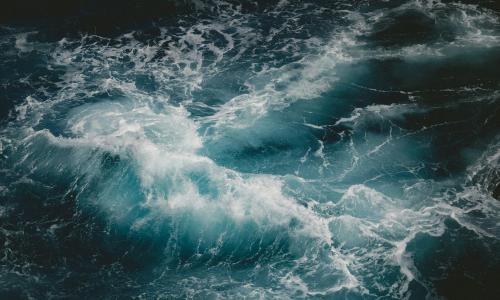An increase in global temperatures will lead to an intensification of the hydrological cycle. This is because an increase in surface air temperature causes an increase in evaporation and generally higher levels of water vapor in the atmosphere. In addition, a warmer atmosphere is capable of holding more water vapor. The excess water vapor will in turn lead to more frequent heavy precipitation when atmospheric instability is sufficient to trigger precipitation events. Intense precipitation can result in flooding, soil erosion, landslides, and damage to structures and crops.
Parallel to the likely increase in heavy precipitation events in winter, increased temperatures will also amplify the drying out of soils and vegetation due to increased evaporation in the summer. This is likely to result in more severe and widespread droughts where and when atmospheric conditions do not favor precipitation (see Droughts and Wildfires).
The largest changes in precipitation are expected at mid- to- high latitudes (Kattenberg et al., 1996). Climate models predict an increase in average precipitation in winter at high latitudes due to poleward transport of evaporated moisture from lower latitudes. There is also an increase in the expected frequency and areal extent of intense precipitation over the continents. Predictions for soil moisture changes are less certain; however, models show an increase in soil moisture in high northern latitudes in winter.
Consistent with model predictions, weather observations over the last century indeed indicate an increase in precipitation over land in the high latitudes of the Northern Hemisphere (Nicholls et al., 1996). For the United States, precipitation since 1970 has averaged about 5% more than in the previous 70 years (Karl et al., 1996), and cold season precipitation has increased by almost 10% during the last century. Over the period 1950 to 1990, annual snowfall increased by about 20% over northern Canada and by about 11% over Alaska (Groisman and Easterling, 1994). An increase in snowfall was also observed in the 1960s and 1970s in China. A recent analysis indicates a trend toward increasing streamflow in most regions of the United States (Lins and Slack, 1999), consistent with the observations of a wetter climate.
Some regions have also experienced an increase in extreme precipitation events, as predicted in model simulations (Nicholls et al., 1996). Observations for the last 100 years indicate that extreme precipitation events (more than 2 inches in 24 hours) in the United States have increased by about 20% (Karl and Knight, 1998). Increases in heavy precipitation have also been reported for Japan and northeastern Australia. An increase in the intensity of precipitation increases flood potential. Although streamflow has increased significantly in the United States since the 1940s, however, there has been no increase in peak flows (Lins and Slack, 1999). Further analysis is needed to reconcile the discrepancy between the findings that the increase in US precipitation has been due primarily to an increase in heavy precipitation (Karl and Knight, 1998) and the analysis that streamflows have become less extreme (Lins and Slack, 1999).
Although it is impossible to link a particular weather event directly to increased greenhouse gases, the heavy precipitation events highlighted on the map are examples of the kind of situations that are expected to become more frequent as climate warms. The magnitude of the human influence relative to natural variability is much larger for temperature compared to precipitation and atmospheric circulation, meaning that a "fingerprint" of anthropogenic warming in precipitation records will emerge much more slowly (Wigley et al., 1999). It may be decades before an unmistakable human signal emerges from the natural background noise.
References
Groisman P.Y. and D.R Easterling, 1994. Variability and trends of precipitation and snowfall over the United States and Canada, Journal of Climate 7, 184-205.
Karl, T. R, R.W. Knight, D.R. Easterling, and R.G. Quayle, 1996. Indices of climate change for the United States, Bulletin of the American Meteorological Society 77 (2), 279-292.
Karl, T.R. and R.W. Knight, 1998. Secular trends of precipitation amount, frequency, and intensity in the United States., Bulletin of the American Meteorological Society 79 (2), 231-241.
Kattenberg, A., F. Giorgi, H. Grassl, G.A. Meehl, J.F.B. Mitchell, R.J. Stouffer, T. Tokioka, A.J. Weaver, and T.M.L. Wigley, 1996. Climate models - projections of future climate, in Climate Change 1995: The Science of Climate Change, 285-357, (Eds J. T. Houghton, L. G. M. Filho, B. A. Callander, N. Harris, A. Kattenberg, and K. Maskell) Cambridge University Press, Cambridge, UK.
Lins, H.F. and J.R. Slack, 1999. Streamflow trends in the United States, Geophysical Research Letters 26 (2), 227-230.
Nicholls, N., G.V. Gruza, J. Jouzel, T.R. Karl, L.A. Ogallo, and D.E. Parker, 1996. Observed climate variability and change, in Climate Change 1995: The Science of Climate Change, (Eds J.T. Houghton, L.G.M. Filho, B.A. Callander, N. Harris, A. Kattenberg, and K. Maskell), 133-192, Cambridge University Press, Cambridge, UK.
Wigley, T.M.L., 1999. The Science of Climate Change: Global and U.S. Perspectives. Pew Center on Global Climate Change, Arlington, Virginia, 48 p.
Additional Resources
Frederick, K.D. and P.H. Gleick, 1999. Water and Global Climate Change: Potential Impacts on U.S. Water Resources. Pew Center on Global Climate Change, Arlington, Virginia, 48 p. http://www.pewclimate.org/projects/clim_change.pdf
NOAA National Climatic Data Center U.S. Heavy Rainfall This website gives 24-hour and annual rainfall records for US states along with descriptions of heavy rainfall and flooding events throughout the world since 1993. http://www.ncdc.noaa.gov/ol/climate/severeweather/
rainfall.html



